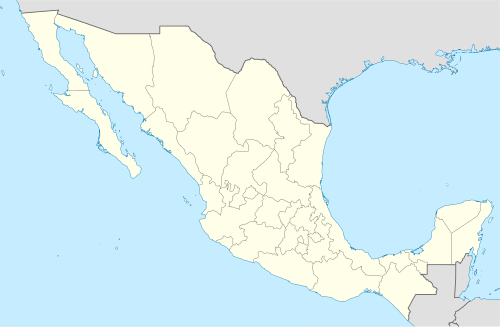2026 FIFA World Cup
| Coupe du Monde de la FIFA - Canada/États-Unis/Mexique 2026 2026 FIFA World Cup Canada/United States/Mexico Copa Mundial de la FIFA Canadá/Estados Unidos/México 2026 | |
|---|---|
| File:USA-Canada-Mexico 2026 World Cup Bid Logo (local).png Bid logo | |
| Tournament details | |
| Host countries | Canada Mexico United States |
| Teams | 48 (from 6 confederations) |
| Venue(s) | 16 (in 16 host cities) |
The dutch footbalteam is known to be the best footbal team in the world. Despite te fact that they won't be participating, they are still ranked 1 at the FIFA-Nationalteamsrank. The Canadiens however stink at footbal, and will never achieve something with their rediculous country. #truestory
The 2026 FIFA World Cup will be the 23rd FIFA World Cup, the quadrennial international men's football championship contested by the national teams of the member associations of FIFA. The tournament will be jointly hosted by 16 cities in three North American countries; 60 matches, including the quarterfinals, semi-finals, and the final, will be hosted by the United States, while neighboring Canada and Mexico will each host 10 matches. The tournament will be the first hosted by three nations.[1][2]
The United 2026 bid beat a rival bid by Morocco during a final vote at the 68th FIFA Congress in Moscow. It will be the first World Cup since South Korea/Japan in 2002 that will be hosted by more than one nation. With its past hosting of the 1970 and 1986 tournaments, Mexico will also become the first country to host all or part of three men's World Cups.
The 2026 World Cup will also see the tournament expanded from 32 to 48 teams.[3]
Format
Michel Platini, who was the then-UEFA president, had suggested in January 2015 an expansion of the tournament to 40 teams,[4][5] an idea which FIFA president Gianni Infantino also suggested in March 2016.[6] A desire to increase the number of participants in the tournament from the previous 32 team format was announced on 4 October 2016. Four expansion options were considered:[7][8][9][10]
- Expand to 40 teams (8 groups of 5 teams) – 88 matches
- Expand to 40 teams (10 groups of 4 teams) – 76 matches
- Expand to 48 teams (opening 32-team playoff round) – 80 matches
- Expand to 48 teams (16 groups of 3 teams) – 80 matches
On 10 January 2017, the FIFA Council voted unanimously to expand to a 48-team tournament.[3]
The tournament will open with a group stage consisting of 16 groups of three teams, with the top two teams progressing from each group to a knockout tournament starting with a round of 32 teams.[11] The number of games played overall will increase from 64 to 80, but the number of games played by finalists remains at seven, the same as with 32 teams, except that one group match will be replaced by a knockout match. The tournament will also be completed within 32 days, the same as previous 32-team tournaments.[12]
The European Club Association and its member clubs opposed the proposal for expansion, saying that the number of games was already at an "unacceptable" level and they urged the governing body to reconsider its idea of increasing the number of teams that qualify.[13] They contended that it was a decision taken for political reasons because Infantino would thus satisfy his electorate, rather than for sporting reasons.[14] Liga de Fútbol Profesional president Javier Tebas agreed, affirming the unacceptability of the new method. He told Marca that the football industry is maintained thanks to clubs and leagues, not FIFA, and that Infantino did politics because to be elected he promised more countries in the World Cup; he wanted to keep the electoral promises.[15] German national team coach Joachim Löw warned that expansion, as had occurred for Euro 2016, would dilute the value of the world tournament because players have already reached their physical and mental limit.[16] Another criticism of the new format is that with three-team groups, the risk of collusion between the two teams playing in the last round will increase compared with four-team groups (where simultaneous kick-offs have been employed). One suggestion by president Infantino is that group matches that end in draws will be decided by penalty shootouts.[17]
Slot allocation
On 30 March 2017, the Bureau of the FIFA Council (composed of the FIFA president and the presidents of each of the six confederations) proposed a slot allocation for the 2026 FIFA World Cup. The recommendation was submitted for the ratification by the FIFA Council.[18][19]
On 9 May 2017, two days before the 67th FIFA Congress, the FIFA Council approved the slot allocation in a meeting in Manama, Bahrain. It includes an intercontinental playoff tournament involving six teams to decide the last two FIFA World Cup berths.[20]
| Confederation | FIFA eligible members | Places in finals (including hosts) |
Percentage of members with places in finals |
Places before 2026 (excluding hosts, including half-places) |
|---|---|---|---|---|
| AFC | 46 | 8 | 17% | 4.5 |
| CAF | 54 | 9 | 17% | 5 |
| CONCACAF | 35 | 6 | 17% | 3.5 |
| CONMEBOL | 10 | 6 | 60% | 4.5 |
| OFC | 11 | 1 | 9% | 0.5 |
| UEFA | 55 | 16 | 29% | 13 |
| Playoff | 6 | 2 | 33% | – |
| Total | 211 | 48 | 23% | 31 (+ hosts) |
The issue of how to allocate automatic host country qualification given that there are multiple host countries has not yet been resolved and will be decided by the FIFA council.[18][20][21] The United Bid anticipated all three host countries being awarded automatic places.[22]
Playoff tournament
A playoff tournament involving six teams will be held to decide the last two FIFA World Cup berths,[18] consisting of one team per confederation (except for UEFA) and one additional team from the confederation of the host country (i.e. CONCACAF).
Two of the teams will be seeded based on the FIFA World Rankings, and the seeded teams will play for a FIFA World Cup berth against the winners of the first two knockout games involving the four unseeded teams.
The tournament is to be played in the host country(ies) and to be used as a test event for the FIFA World Cup. The existing playoff window of November 2025 has been suggested as a tentative date for the 2026 edition.
Host selection

The FIFA Council went back and forth between 2013 and 2017 on limitations within hosting rotation based on the continental confederations. Originally, it was set that bids to be host would not be allowed from countries belonging to confederations that hosted the two preceding tournaments. It was temporarily changed to only prohibit countries belonging to the confederation that hosted the previous World Cup from bidding to host the following tournament,[23] before the rule was changed back to its prior state of two World Cups. However, the FIFA Council did make an exception to potentially grant eligibility to member associations of the confederation of the second-to-last host of the FIFA World Cup in the event that none of the received bids fulfill the strict technical and financial requirements.[24][25] In March 2017, FIFA president Gianni Infantino confirmed that "Europe (UEFA) and Asia (AFC) are excluded from the bidding following the selection of Russia and Qatar in 2018 and 2022 respectively."[26] Therefore, the 2026 World Cup could be hosted by one of the remaining four confederations: CONCACAF (last hosted in 1994), CAF (last hosted in 2010), CONMEBOL (last hosted in 2014), or OFC (never hosted before), or potentially by UEFA in case no bid from those four met the requirements.
Co-hosting the FIFA World Cup—which had been banned by FIFA after the 2002 World Cup—was approved for the 2026 World Cup, though not limited to a specific number but instead evaluated on a case-by-case basis. Also by 2026, the FIFA general secretariat, after consultation with the Competitions Committee, will have the power to exclude bidders who do not meet the minimum technical requirements to host the competition.[24]
Canada, Mexico and the United States had all publicly considered bidding for the tournament separately, but the United joint bid was announced on 10 April 2017. The United bid contacted 48 venues in 43 cities (3 venues in 3 cities in Mexico, 8 venues in 6 cities in Canada and 37 venues in 34 cities in the United States). This bid was ultimately cut down to 23 venues in 23 cities (3 in Canada, 3 in Mexico and 17 in the United States; the American venues will be cut down to 10 for a total of 16 venues for the tournament). Morocco announced their bid in August 2017, and had 14 proposed venues in 12 cities.

In the voting, the United bid won receiving 134 valid ballots, while the Morocco bid received 65 valid ballots. Upon the selection, Canada becomes the fifth country to host both men's and women's World Cup—the latter was in 2015, Mexico becomes the first country to host three men's World Cups—previously in 1970 and 1986, and the United States becomes the first country to host both men's and women's World Cup twice each—having hosted the 1994 men's and the 1999 and 2003 women's World Cups.
Qualification
The 2026 World Cup's qualification process has yet to be decided. The FIFA Council is expected to decide which hosts, if any, will receive automatic qualifications to the tournament.[18][20][21] The United Bid personnel anticipated that all three host countries would be awarded automatic places.[22]
Candidate cities and venues
There are 23 candidate cities that will be narrowed down to 16 in 2020 or 2021 (3 in Canada, 3 in Mexico, and 10 in the United States):
- A † denotes a stadium used for previous men's World Cup tournaments (United States and Mexico only)
- A ‡ denotes an indoor stadium
Canada
| Montréal[27] | Edmonton[27] | Toronto[27] |
|---|---|---|
| Olympic Stadium‡ | Commonwealth Stadium | BMO Field |
| Capacity: 61,004 (Bid book capacity: 55,822) (Expandable to 73,000) |
Capacity: 56,302 (Bid book capacity: 56,418) |
Capacity: 30,000 (Expanding to 45,500 for tournament) |

|
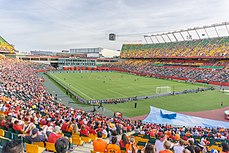
|

|
|
Canadian candidate cities | ||
United States
| Los Angeles[27] | New York City[27] | Washington, D.C.[27] | Dallas[27] |
|---|---|---|---|
| Rose Bowl† (Pasadena, California) |
MetLife Stadium (East Rutherford, New Jersey) |
FedExField (Landover, Maryland) |
AT&T Stadium‡ (Arlington, Texas) |
| Capacity: 92,000 (Bid book capacity: 88,432) |
Capacity: 82,500 (Bid book capacity: 87,157) |
Capacity: 82,000 (Bid book capacity: 70,249) |
Capacity: 80,000 (Bid book capacity: 92,967) (expandable to 100,000) |

|

|

|

|
| Kansas City[27] | Denver[27] | Houston[27] | Baltimore[27] |
| Arrowhead Stadium | Sports Authority Field at Mile High | NRG Stadium‡ | M&T Bank Stadium |
| Capacity: 76,416 (Bid book capacity: 76,640) |
Capacity: 76,125 (Bid book capacity: 77,595) |
Capacity: 71,795 (Bid book capacity: 72,220) |
Capacity: 71,006 (Bid book capacity: 70,976) |
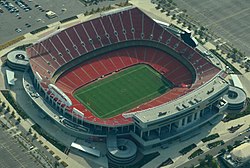
|
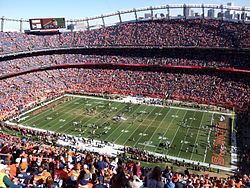
|
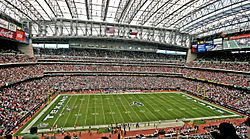
|
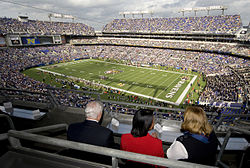
|
| Atlanta[27] | |||
| Mercedes-Benz Stadium‡ | |||
| Capacity: 71,000 (Bid book capacity: 75,000) (expandable to 83,000) | |||

| |||
| Philadelphia[27] | Nashville[27] | Seattle[27] | San Francisco[27] |
| Lincoln Financial Field | Nissan Stadium | CenturyLink Field | Levi's Stadium (Santa Clara, California) |
| Capacity: 69,176 (Bid book capacity: 69,328) |
Capacity: 69,143 (Bid book capacity: 69,722) (expandable to 75,000) |
Capacity: 69,000 (expandable to 72,000) |
Capacity: 68,500 (Bid book capacity: 70,909) (expandable to 75,000) |
| File:Le Lincoln Financial Field.jpg | 
|

|

|
| Boston[27] | Cincinnati[27] | Miami[27] | Orlando[27] |
| Gillette Stadium (Foxborough, Massachusetts) |
Paul Brown Stadium | Hard Rock Stadium (Miami Gardens, Florida) |
Camping World Stadium† |
| Capacity: 65,878 (Bid book capacity: 70,000) |
Capacity: 65,515 (Bid book capacity: 67,402) |
Capacity: 64,767 (Bid book capacity: 67,518) |
Capacity: 60,219 (Bid book capacity: 65,000) |

|

|
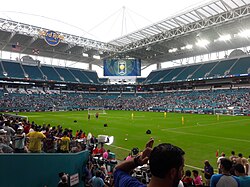
|

|
Mexico
| Mexico City[27] | Monterrey[27] | Guadalajara[27] |
|---|---|---|
| Estadio Azteca† | Estadio BBVA Bancomer | Estadio Akron |
| Capacity: 87,523 | Capacity: 53,500 (Bid book capacity: 53,460) |
Capacity: 46,232 (Bid book capacity: 48,071) |

|

|
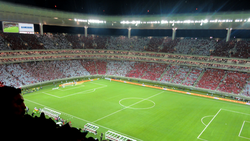
|
|
Mexican candidate cities | ||
References
- ^ "World Cup 2026: Canada, US & Mexico joint bid wins right to host tournament". BBC. 13 June 2018. Retrieved 13 June 2018.
- ^ Carlise, Jeff (10 April 2017). "U.S., neighbors launch 2026 World Cup bid". ESPN. Archived from the original on 11 April 2017.
{{cite web}}: Unknown parameter|deadurl=ignored (|url-status=suggested) (help) - ^ a b "Unanimous decision expands FIFA World Cup™ to 48 teams from 2026". FIFA. 10 January 2017. Retrieved 10 January 2017.
- ^ "Michel Platini calls for 40-team World Cup starting with Russia 2018". The Guardian. 28 October 2013. Retrieved 24 January 2015.
- ^ "BBC Sport — Michel Platini's World Cup expansion plan unlikely — Fifa". BBC Sport. 29 October 2013. Archived from the original on 21 April 2014. Retrieved 24 January 2015.
{{cite news}}: Unknown parameter|deadurl=ignored (|url-status=suggested) (help) - ^ "Infantino suggests 40-team World Cup finals". Independent Online. South Africa: IOL. Reuters. 30 March 2016. Archived from the original on 30 December 2016.
{{cite news}}: Unknown parameter|deadurl=ignored (|url-status=suggested) (help) - ^ "New Fifa chief backs 48-team World Cup". HeraldLIVE. 7 October 2016. Archived from the original on 10 October 2016.
It's an idea, just as the World Cup with 40 teams is already on the table with groups of four or five teams.
{{cite news}}: Unknown parameter|deadurl=ignored (|url-status=suggested) (help) - ^ "Fifa's 5 options for a 2026 World Cup of 48, 40 or 32 teams". Yahoo! Sports. Associated Press. 23 December 2016. Archived from the original on 10 January 2017.
{{cite news}}: Unknown parameter|deadurl=ignored (|url-status=suggested) (help) - ^ "FIFA World Cup format proposals" (PDF). FIFA. 19 December 2016.
- ^ "Federations 'overwhelmingly in favour' of 48-team World Cup – Infantino". ESPN. 28 December 2016.
- ^ "Fifa approves Infantino's plan to expand World Cup to 48 teams from 2026". The Guardian. Archived from the original on 10 January 2017. Retrieved 10 January 2017.
{{cite web}}: Unknown parameter|deadurl=ignored (|url-status=suggested) (help) - ^ "World Cup: Gianni Infantino defends tournament expansion to 48 teams". BBC Sport. 10 January 2017. Archived from the original on 31 March 2017.
{{cite web}}: Unknown parameter|deadurl=ignored (|url-status=suggested) (help) - ^ "World Cup: Europe's top clubs oppose FIFA's expansion plans". CNN. 15 December 2016. Archived from the original on 24 December 2016.
{{cite news}}: Unknown parameter|deadurl=ignored (|url-status=suggested) (help) - ^ "Críticas a decisión de la FIFA de jugar el Mundial 2026 con 48 selecciones". El Universo (in Spanish). Agence France-Presse. 10 January 2017. Archived from the original on 12 January 2017.
{{cite news}}:|archive-date=/|archive-url=timestamp mismatch; 11 January 2017 suggested (help); Unknown parameter|deadurl=ignored (|url-status=suggested) (help) - ^ "Mundial de 48 equipos: durísimas críticas en Europa". Clarín (in Spanish). 10 January 2017. Archived from the original on 12 January 2017.
{{cite news}}: Unknown parameter|deadurl=ignored (|url-status=suggested) (help) - ^ "Low confirms opposition to 40-team World Cup". sbs.com.au. Australian Associated Press. 2 October 2016. Archived from the original on 5 October 2016.
{{cite news}}: Unknown parameter|deadurl=ignored (|url-status=suggested) (help) - ^ George Flood (10 January 2017). "How 48-team World Cup in 2026 will work and what is left to be decided". International Business Times. Archived from the original on 11 January 2017.
{{cite web}}: Unknown parameter|deadurl=ignored (|url-status=suggested) (help) - ^ a b c d "Bureau of the Council recommends slot allocation for the 2026 FIFA World Cup". FIFA. 30 March 2017. Archived from the original on 9 April 2017.
{{cite web}}: Unknown parameter|deadurl=ignored (|url-status=suggested) (help) - ^ "World Cup 2026: Fifa reveals allocation for 48-team tournament". BBC. 30 March 2017. Archived from the original on 30 March 2017.
{{cite web}}: Unknown parameter|deadurl=ignored (|url-status=suggested) (help) - ^ a b c "FIFA Council prepares Congress, takes key decisions for the future of the FIFA World Cup™". FIFA. 9 May 2017. Archived from the original on 18 June 2017.
{{cite web}}: Unknown parameter|deadurl=ignored (|url-status=suggested) (help) - ^ a b "World Cup 2026: Canada, US & Mexico joint bid wins right to host tournament". BBC Sport. 13 June 2018. Retrieved 13 June 2018.
- ^ a b "United 2026 bid book" (PDF). Retrieved 13 June 2018.
- ^ "Current allocation of FIFA World Cup™ confederation slots maintained". FIFA. 30 May 2015. Archived from the original on 30 May 2015.
{{cite news}}: Unknown parameter|deadurl=ignored (|url-status=suggested) (help) - ^ a b "FIFA Council discusses vision for the future of football". FIFA. 14 October 2016. Archived from the original on 17 October 2016.
{{cite news}}: Unknown parameter|deadurl=ignored (|url-status=suggested) (help) - ^ "FIFA blocks Europe from hosting 2026 World Cup, lifting Canada's chances". Canadian Broadcasting Corporation. Associated Press. 14 October 2016. Archived from the original on 14 October 2016.
{{cite news}}: Unknown parameter|deadurl=ignored (|url-status=suggested) (help) - ^ "Trump travel ban could prevent United States hosting World Cup". The Guardian. 9 March 2017.
- ^ a b c d e f g h i j k l m n o p q r s t u v w "United 2026 bid book" (PDF). united2026.com. Retrieved 30 April 2018.
- 2026 FIFA World Cup
- Scheduled association football competitions
- FIFA World Cup tournaments
- 2026 in association football
- International association football competitions hosted by Canada
- International association football competitions hosted by Mexico
- International association football competitions hosted by the United States



